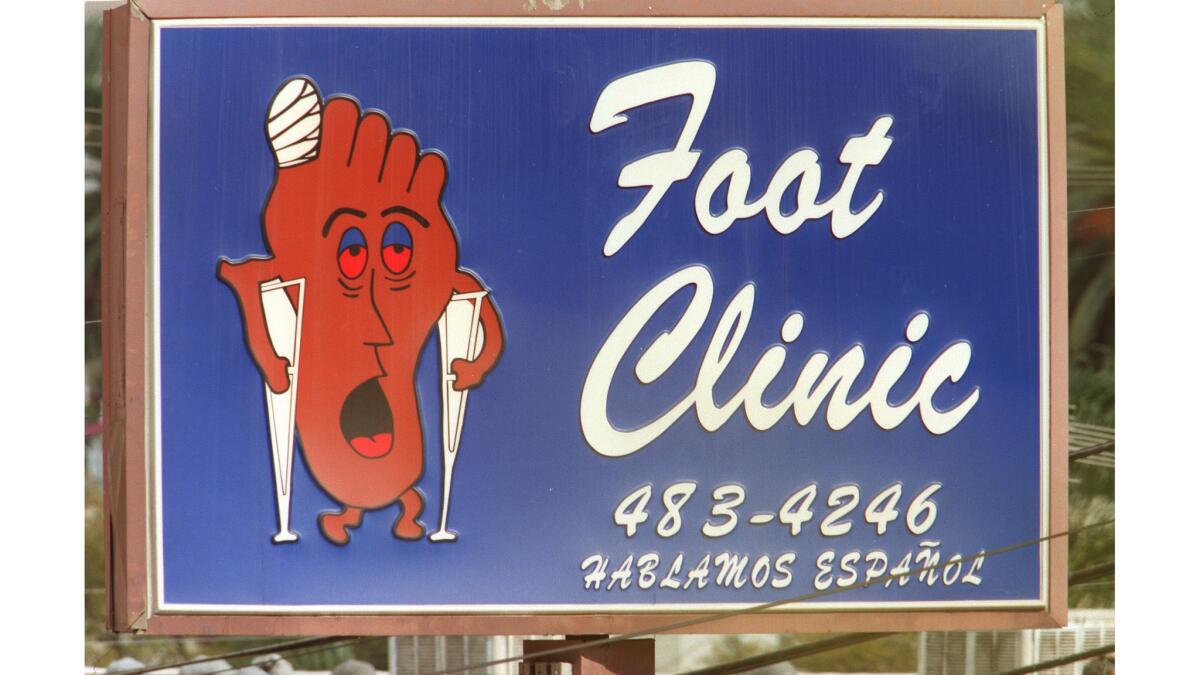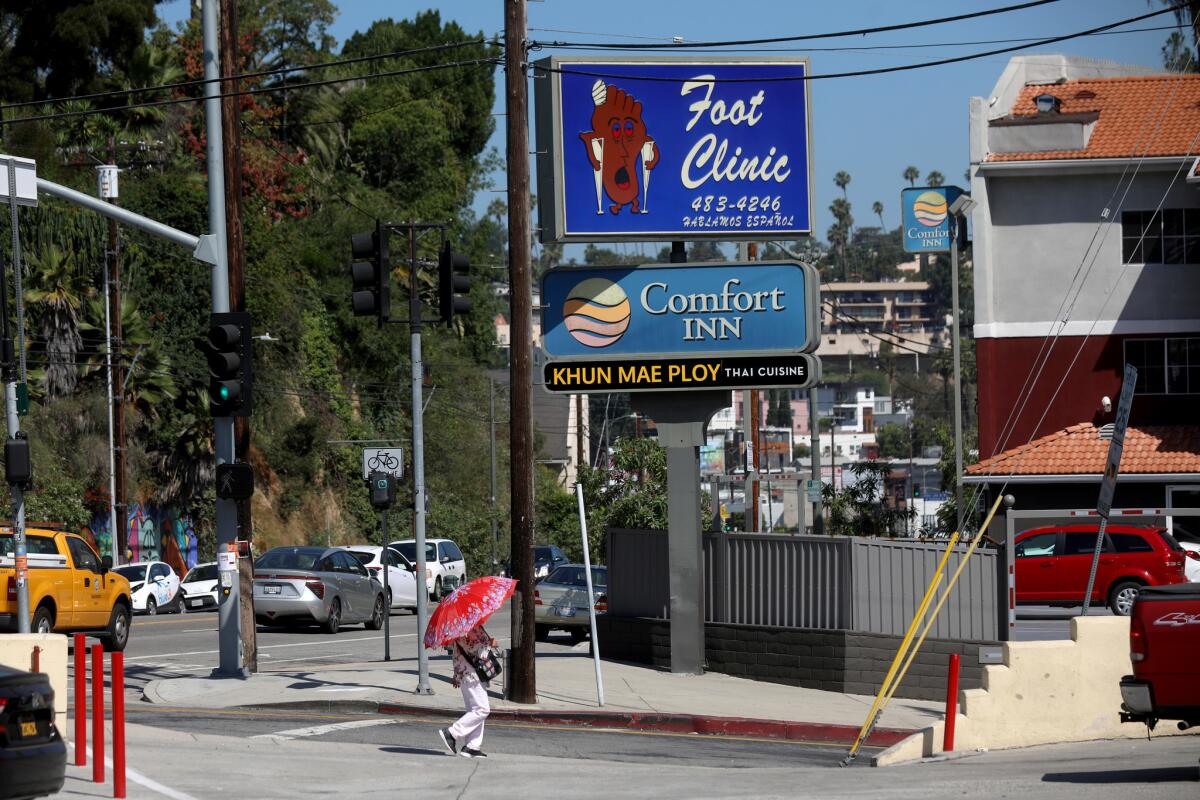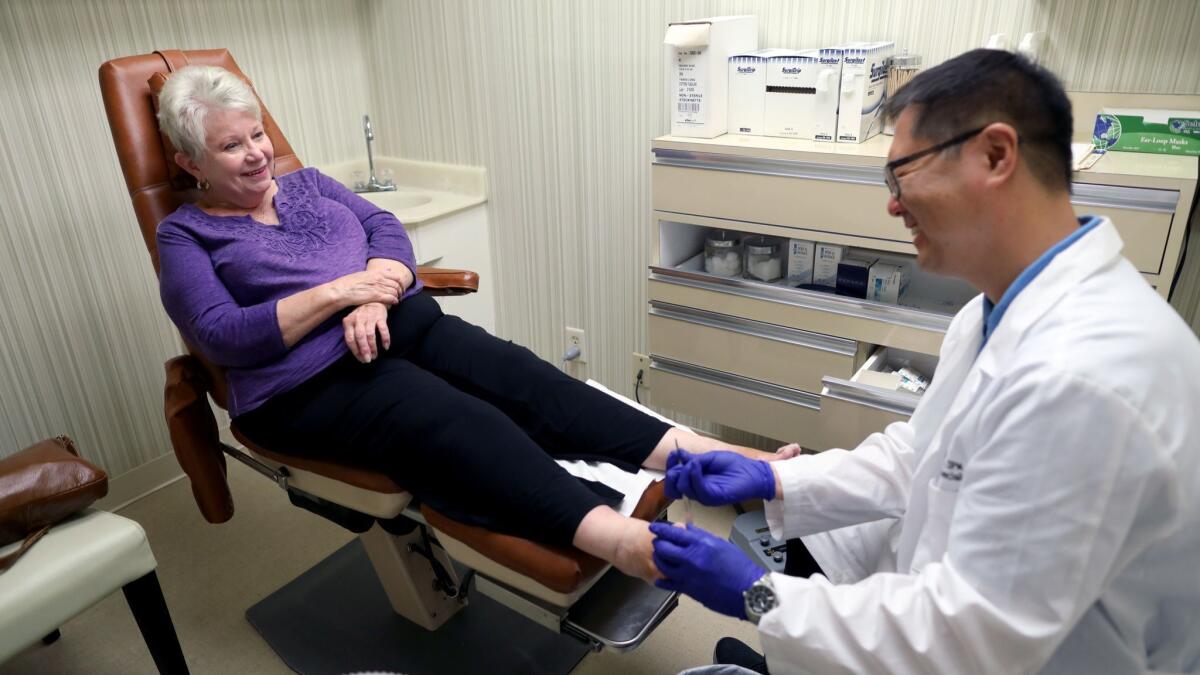Column: For the doctor behind Happy Foot Sad Foot sign, a strange kind of fame comes to an end

- Share via
Over the last four decades, the Happy Foot Sad Foot sign at the corner of Sunset Boulevard and Benton Way has become the neighborhood’s mascot and mood ring.
The more mystical residents of Echo Park swear the sign works like a giant rotating fortune cookie or tarot card. If you see the sign on its happy side, you’ll have a good day, and if you see the sad side, you’ll have a bad day.
I’m not superstitious enough for that. But I’ve always loved the sign because I’ve always felt like it was talking to me. On a good day, the happy foot is a fond reminder of the endlessly strange city I get to live in and explore. If I’m having a bad day, the sad foot, with its bloodshot eyes, crutches, bandaged toe and expression of comic distress, seems to say both “we’ve all been there,” and “it could be worse.”
And no matter what kind of day I’m having, when the sign rotates to the other side, it’s a reminder that nothing lasts — so get ready.
It’s one of those uniquely Los Angeles landmarks that begin life as objects of revulsion or disdain, then become ironically celebrated by a later generation of residents and are eventually anointed as fondly, iconically weird by another. As we drive around the city, these objects wash up on the shores of our consciousness like strange flotsam, beautiful for the way they play against the drab or dingy or stereotypically hip.
It reminds me of how “western” is spelled backward on Pollo a la Brasa’s sign, or what the giant, levitating teapot fountain on Valley Boulevard in Temple City will probably be to someone, someday.

RELATED: The Silver Lake Happy Foot Sad Foot sign is getting the boot »
The other day I read in the Eastsider that the sign was coming down, and for the first time in more than a decade it occurred to me that it belonged to an actual foot doctor’s office, run by an actual person. And I started to wonder, with all that I’ve read about the sign over the years, why I knew so little about the guy running it.
So last week I decided to visit Dr. Thomas Lim of Sunset Foot Clinic and get to know him.
He was somewhat surprised to see me. Despite all of the attention the foot sign has received, he said I was the first journalist to ever come by the office in person.
It’s a strange kind of fame, being the owner of an ironically beloved sign. He doesn’t get recognized at the post office or anything, but the musician Beck has mentioned his sign in interviews and novelist Jonathan Lethem used it as a metaphor for the duality of human emotion in his 2007 novel “You Don’t Love Me Yet.”
A lot of people are shocked to discover that the sign is associated with an actual foot clinic. But a Los Angeles Football Club fan collective has adopted Lim’s sign as a mascot, and recently he noticed that a store down the street is selling T-shirts with the sign’s image.
He does get some calls about it, but mostly when the sign breaks down. But he’s used to flying under the radar after 12 years in the foot care business. People never pay attention to their feet until something goes wrong.
“Your feet are hidden, and people don’t care about it as much. People tend to push it away, until things get really bad,” Lim said.

Lim is a practical guy and doesn’t get too superstitious about the sign. If it makes him think of anything, it’s about the ’80s, and how much things have changed in the neighborhood since then.
He pointed out that the foot is a medium-to-dark brown color, and the sign was erected during a time when more Latino and Philippine immigrants lived around there. He isn’t sure, because he inherited the sign, but he thinks the foot is probably Latino.
When he started working there in 2007, 75% of his clientele were Latino, and now less than 25% of his clients are. A lot of his old patients have been priced out of the neighborhood.
But Lim appreciates the attention the sign has brought. Growing up in the San Fernando Valley with Korean immigrant parents who had to work all the time, he never really felt like he lived in the Los Angeles everyone talks about. He remembers passing the Hollywood Bowl on trips to Koreatown and never really knowing what it was.
“I knew the Valley, and I knew Koreatown, but I had no idea what was in between,” Lim said.
Lim has never been someone who seeks attention — in high school he was actually awarded the superlative “Most Typical Senior.”
He likes that sometimes customers come in just because of the sign, but he also likes the idea of being up in the pantheon of iconic L.A. quirkiness.
“Maybe because we’re leaving, I didn’t realize how much I actually like it or really needed it,” Lim said. “The sign gave me my identity without me even realizing I was looking for an identity.”
I asked him if the sign made him feel like anything, as it has for so many. Could he see its emotional duality in his own life? We both laughed as I asked the question, aware of how ridiculous we sounded.
He was quiet for a long time, and then said, “Not really.” But then I asked him about growing up in the San Fernando Valley.
He tells me his parents immigrated to the U.S. in 1979 from South Korea and ran a liquor store in Granada Hills. He was a latchkey kid who signed all his own report cards and could tell time by which TV shows were on: “Three’s Company” at 6 p.m., then “Too Close for Comfort,” then “Jeopardy!” and “Wheel of Fortune.”
He saw his parents so rarely that in high school, he started visiting them on Friday nights while his friends went to the movies, just to see them. His parents worked from 9 a.m to 11 p.m. and never took time off or vacation. They ate all their meals and celebrated their holidays there, seated on overturned milk crates, balancing plates on top of boxes of Popov vodka.
These aren’t exactly pleasant memories for him. Near his clinic there’s a hip restaurant that seats customers on milk crates, and he can’t bring himself to eat there. There’s a new sitcom about a Korean immigrant family running a convenience store, and he can’t get into it. I tell him about a forthcoming indie documentary about the children of Korean liquor store owners, and he feels conflicted about it.
“If the only bond you have is the bond of struggle, it’s a strong bond but it’s not a fun bond,” Lim said.
I ask him if he has any happy memories with his family, and he’s silent again. He can’t think of any, but he pulls out his phone and starts showing me pictures of his kids at Disneyland and the Hollywood Bowl.
As a father, Lim said, he made a special effort to share interests with his kids, introducing them to K-pop, quizzing them on Harry Potter spells and taking them to see “Star Wars” movies. He couldn’t relate much with his parents growing up because he couldn’t speak Korean well enough. He wanted it to be different with his own kids.
I told him that to me, it seemed as if the sign could be a metaphor for his own life. That you could draw a line from his family’s struggles to the pictures of the happy family on his phone, from the liquor store to the foot clinic. That one generation’s hardship births another generation’s happiness, a cycle that goes on and on. Sad foot, happy foot.
Lim, upon hearing this, laughed self-consciously and rolled his eyes.
“That’s so cheesy. So cheesy,” he said, shaking his head. “But it’s, I guess, kind of accurate.”
Maybe I’m just someone who likes to tell cheesy stories. But now, when I think of the sign, I’ll remember the story of the Lim family and the “typical senior” who grew up to run a foot clinic beneath a sign that became a beloved local landmark. Because his story in a lot of ways is my story, and the story of so many of us here in this city. These stories aren’t stereotypes unless we see them that way, and though we often overlook them, they are just as worth telling.
Out of curiosity, I asked Lim whether his parents’ liquor store had an interesting sign, and the next day he texted me a picture.
It’s a big, complicated thing in bright yellow, red, blue and white, framed in movie marquee lights and swooping Googie-style shapes. A masterpiece in its own right.
More to Read
Sign up for Essential California
The most important California stories and recommendations in your inbox every morning.
You may occasionally receive promotional content from the Los Angeles Times.











